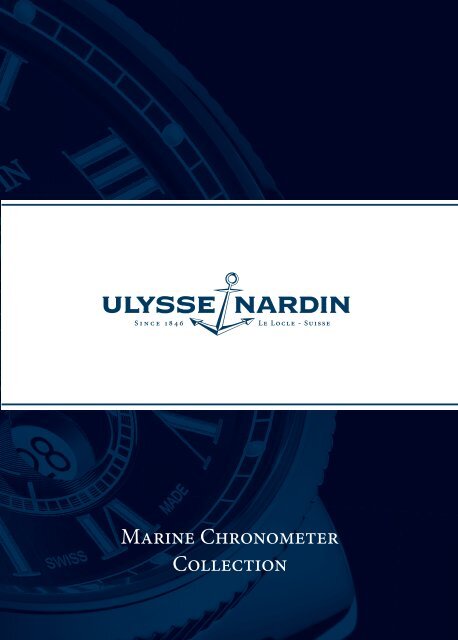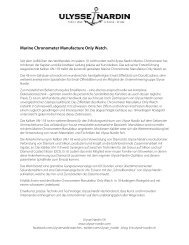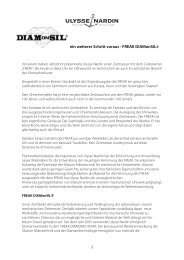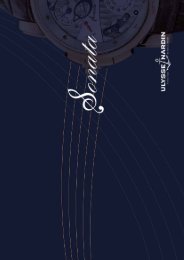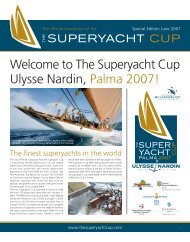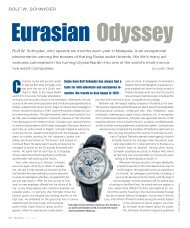Setting Instructions - Ulysse Nardin
Setting Instructions - Ulysse Nardin
Setting Instructions - Ulysse Nardin
You also want an ePaper? Increase the reach of your titles
YUMPU automatically turns print PDFs into web optimized ePapers that Google loves.
Marine Chronometer<br />
Collection
2<br />
Marine Chronometer<br />
Collection
4<br />
Contents<br />
English<br />
<strong>Ulysse</strong> <strong>Nardin</strong> and Marine Chronometer ................................................. 8<br />
Crown positions ......................................................................................... 10<br />
Time setting / Date setting / Power reserve indicator /<br />
Chronometer Certificate C.O.S.C. / Special feature .................................. 11<br />
Precision / Water-resistance / Maintenance ............................................... 12<br />
Technical data ............................................................................................. 13<br />
Français<br />
Positions de la couronne ............................................................................ 14<br />
Mise à l’heure / Réglage de la date / Indicateur de la réserve de<br />
marche / Certificat de Chronomètre C.O.S.C. / Remarque ...................... 15<br />
Précision / Etanchéité / Entretien .............................................................. 16<br />
Informations techniques ............................................................................ 17<br />
Deutsch<br />
Kronen Positionen ..................................................................................... 18<br />
Zeiteinstellung / Datumseinstellung / Gangreserveanzeige /<br />
Chronometer Zertifikat C.O.S.C. / Besonderheit ..................................... 19<br />
Die Genauigkeit / Die Wasserdichtigkeit / Die Wartung .......................... 20<br />
Technische Informationen ......................................................................... 21<br />
Español<br />
Posiciones de la corona .............................................................................. 22<br />
Ajuste de la hora / Ajuste de la fecha / Indicador de reserva<br />
de marcha / Certificado de Cronómetro C.O.S.C. / Nota ........................ 23<br />
Precisión / Hermeticidad / Mantenimiento .............................................. 24<br />
Datos técnicos ............................................................................................ 25
Italiano<br />
Posizione della corona ............................................................................... 28<br />
Regolazione del ora / Regolazione del datario / Indicatore di riserva<br />
di carica / Certificato di Cronometro dato dal C.O.S.C. /<br />
Annotazione ............................................................................................... 29<br />
Precisione / Impermeabilità / Mantenimento ........................................... 30<br />
Dati tecnici ................................................................................................. 31<br />
............................................................... 32<br />
........................... 33<br />
....................................... 34<br />
................................................................................ 35<br />
................................................................................................ 36<br />
其它特征 ....................................................................... 37<br />
................................................................ 38<br />
..................................................................................................... 39<br />
................................................................................................ 40<br />
........................................................................... 41<br />
.............................................................. 42<br />
..................................................................................................... 43<br />
5
8<br />
<strong>Ulysse</strong> <strong>Nardin</strong> and<br />
Marine Chronometer<br />
Traditional birthplace of prestige watch making, the Swiss mountain<br />
region of the Canton of Neuchâtel had no particular relation to the vast<br />
open seas.<br />
Perched at 1000 meters above sea level, at the heart of Europe, the<br />
Neuchâtel watchmakers had only a distant vision of the sea. Nonetheless,<br />
it was on the seas that the watchmaker <strong>Ulysse</strong> <strong>Nardin</strong> and his descendants<br />
earned their greatest renown.<br />
<strong>Ulysse</strong> <strong>Nardin</strong> was only 23 years old in 1846 when he settled in Le<br />
Locle to develop his own chronometers and complex pocket watches,<br />
bringing with him a wealth of experience gained while working with<br />
Federic-William Dubois, a specialist in manufacturing marine<br />
chronometers and astronomic watches.<br />
The young entrepreneur’s reputation for technical excellence rapidly spread<br />
well beyond regional and national borders.<br />
In 19th century Europe, marked by the industrial revolution, people started<br />
to discover the benefits of mechanization. Methods of transport were<br />
limited. <strong>Ulysse</strong> <strong>Nardin</strong> products were often shipped from Basel down the<br />
river Rhine for distribution to the great tollships which criss-crossed the<br />
globe at the time.<br />
Conquering the Oceans<br />
Brigs, frigates, schooners and clippers have written important chapters in<br />
the history of world shipping and the development of international trade.<br />
<strong>Ulysse</strong> <strong>Nardin</strong>, an astute businessman, saw the opportunity and moved into<br />
manufacturing marine chronometers.
In those days, when sailors navigated by means of a sextant with the sun<br />
and the horizon to guide them, they only had one precise reference on<br />
board - their marine chronometers.<br />
This time-keeping instrument, with its 2 or 8 days power reserve marked<br />
the half-seconds and made it possible to determine the exact longitude<br />
while a ship was at sea. The faultless precision of the instrument was a<br />
necessity. At the Equator, a single second’s difference corresponds to an<br />
error of 463 meters.<br />
Riding the Waves<br />
From 1876 onwards, the House of <strong>Ulysse</strong> <strong>Nardin</strong> regularly submitted<br />
Marine Chronometers to the Neuchatel and Geneva Observatories where<br />
they underwent stringent testings: 9 test runs of 7 days each at temperatures<br />
of 36, 28, 20, 12 and 4 degrees, then again 12, 20, 28 and 36 degrees. The<br />
“to and fro” was aimed at proving the exemplary precision of the<br />
timekeepers under extrem conditions. The results confirmed the<br />
preeminence of the Le Locle firm in one of the most demanding<br />
specialties in the art of watch making.<br />
<strong>Ulysse</strong> <strong>Nardin</strong>’s achievements in the development of marine<br />
chronometers were honored with the highest distinctions throughout the<br />
world. The firm gained over 4300 1st prizes and 18 gold medals at world<br />
fairs and international exhibitions. Its marine chronometers equipped over<br />
50 navies on all 5 continents.<br />
Today, satellites have replaced the marine chronometer and the sextant as<br />
navigation instruments. Nonetheless, <strong>Ulysse</strong> <strong>Nardin</strong> marine chronometers<br />
are still prized by enthusiasts and collectors.<br />
9<br />
English
10<br />
Crown positions<br />
Caliber UN-26<br />
A Crown screwed down.<br />
A B C D<br />
B To wind the movement: unscrew and turn crown clockwise. If the<br />
watch has stopped, approx. 30 turns of the crown will wind it.<br />
C Quick date setting.<br />
Important : do not use quick corrector between 9 : 00 pm and 3 : 00 am ;<br />
doing so may result in damage to the calendar mechanism.<br />
D Time setting. When corrections and adjustments are completed,<br />
push the crown and screw down to position A to guarantee full<br />
water-resistance.
Time setting<br />
Pull crown out to position D. Make sure the hands are properly showing<br />
either am or pm, otherwise the date will change at noon instead of<br />
midnight. Turn the hands clockwise to the desired time. Push crown back<br />
to position B, then press slightly to engage the threads and turn to screw the<br />
crown down. Only when the crown is screwed down can water-resistance<br />
be guaranteed.<br />
Date setting<br />
Unscrew the crown and pull out to position C. Rotate anti-clockwise until<br />
the required date appears in the window.<br />
Power reserve indicator<br />
The self-winding movement is fully wound when the hand on the counter<br />
at 12 o’clock is on position “UP”. The movement has a power reserve of<br />
approximately 42 hours.<br />
Chronometer Certificate C.O.S.C.<br />
Each caliber UN-26 is numbered and equipped with a Chronometer<br />
Certificate awarded by the Swiss Official Chronometer Control to certify<br />
the reliability of this exceptional timepiece.<br />
Special feature<br />
On the stainless steel models, all parts touching the wrist, i.e. the case<br />
back and the metal parts and the folding buckle of the adjustable rubber<br />
strap are made of skin friendly titanium.<br />
11<br />
English
12<br />
Precision<br />
Precision and average daily rate depend on the activity of the person<br />
wearing the instrument. Magnetic fields (computers, mobile phones, etc.)<br />
may influence the working of a watch. Violent shocks or knocks - quite<br />
common in tennis or golf − should be avoided to prevent shaking that<br />
may loosen certain parts.<br />
Because a mechanical watch is a fine piece of miniature engineering<br />
consisting of well over 100 individual parts, its precision will never match<br />
that of a quartz timepiece.<br />
Water-resistance<br />
If an instrument features a screw down security crown, it is important to<br />
screw it back down to the original position to assure water-resistance.<br />
After an immersion in salt water, we recommend that you simply rinse the<br />
watch with clear water.<br />
Maintenance<br />
All mechanical watches should have their movements cleaned and the oil<br />
replaced every 3-5 years. The life span of any mechanical timepiece will<br />
primarily depend upon both daily care and the recommended routine<br />
maintenance. We strongly encourage you to have your timepiece serviced<br />
only at officially authorized <strong>Ulysse</strong> <strong>Nardin</strong> After Sales Service departments.<br />
For additional information regarding After Sales Service please visit our<br />
website: www.ulysse-nardin.com.
Technical data<br />
Caliber UN-26<br />
Type Mechanical self-winding movement<br />
Functions Chronometer C.O.S.C. with power reserve<br />
indicator<br />
Size 11 ½”<br />
Diameter of movement 25.60 mm<br />
Height of movement 5.10 mm<br />
Number of jewels 28 jewels<br />
Oscillations 28’800/h (4Hz)<br />
Power reserve Approx. 42 hours<br />
Crown Screw down security crown<br />
Glass Anti-reflection sapphire crystal<br />
Display Hour and minute hands in the center,<br />
oversized small seconds and round date window<br />
at 6 o’clock. Power reserve indicator at<br />
12 o’clock.<br />
Watch winders Min. of 850 rotations/day to maintain power.<br />
Winding of movement: bi-directional.<br />
13<br />
English
14<br />
Positions de la couronne<br />
Calibre UN-26<br />
A Position normale, couronne vissée.<br />
A B C D<br />
B Remontage: dévisser la couronne et la tourner en sens horaire.<br />
Lorsque la montre est arrêtée, tourner la couronne env. 30 tours<br />
pour remonter le mécanisme.<br />
C Correction rapide du quantième.<br />
Important : aucune correction rapide entre 21h et 3h du matin ce qui<br />
peut endommager le mécanisme du calendrier.<br />
D Mise à l’heure (une fois les réglages terminés, remettre la couronne en<br />
position A pour garantir la parfaite étanchéité de la montre).
Mise à l’heure<br />
Tirer la couronne en position D. Tourner la couronne jusqu’à ce que les<br />
aiguilles indiquent l’heure requise. Repousser la couronne en position B,<br />
appliquer une légère pression axiale et visser la couronne jusqu’à ce qu’elle<br />
termine sa course en butée, position A. L’étanchéité de votre montre est<br />
alors garantie.<br />
Réglage de la date<br />
Dévisser la couronne, la tirer en position C et tourner en sens anti-horaire<br />
jusqu’à ce que la date souhaitée apparaisse dans le guichet.<br />
Indicateur de la réserve de marche<br />
Le mouvement est remonté lorsque l’aiguille du petit compteur à 12h vise<br />
la mention «UP» (remontage haut). Le mouvement dispose d’une réserve<br />
de marche d’environ 42 heures.<br />
Certificat de Chronomètre C.O.S.C.<br />
Les calibres UN-26 sont numérotés individuellement et accompagnés<br />
d’un certificat de chronomètre établi par le Contrôle Officiel Suisse des<br />
Chronomètres, lequel certifie la précision et la fiabilité de l’instrument.<br />
Remarque<br />
Sur les modèles en acier inoxydable, tous les composants métalliques<br />
en contact avec la peau, soit le fond du boîtier, les éléments incorporés<br />
au bracelet, ainsi que le fermoir du bracelet caoutchouc sont en titane,<br />
matériau reconnu anti-allergique.<br />
15<br />
Français
16<br />
Précision<br />
A noter que la bonne marche et la précision d’une montre dépendent<br />
de la personne qui la porte et de son activité. Les champs magnétiques<br />
(ordinateurs, téléphones portables, etc.) peuvent influencer sa marche. Les<br />
activités, telles que tennis, golf ou toute autre qui provoqueraient des chocs<br />
violents sont à proscrire.<br />
Jamais une montre mécanique n’aura la précision d’une montre à quartz.<br />
Etanchéité<br />
L’instrument étant équipé d’une couronne vissée, il est important de la<br />
remettre en position initiale après utilisation.<br />
Après toute immersion en eau de mer, il est conseillé de rincer votre montre<br />
à l’eau douce.<br />
Entretien<br />
Comme pour le moteur d’une voiture, il est recommandé d’effectuer une<br />
révision du mouvement tous les 3 à 5 ans. La longévité de votre instrument<br />
dépend du soin et de l’entretien apporté. La qualité du service après vente<br />
joue également un rôle important. Veuillez contacter exclusivement les<br />
centres d’assistance agréés ou directement <strong>Ulysse</strong> <strong>Nardin</strong> Le Locle, Suisse.<br />
Pour plus de renseignements en rapport avec l’entretien, veuillez consulter<br />
le site web d’<strong>Ulysse</strong> <strong>Nardin</strong> : www.ulysse-nardin.com.
Informations techniques<br />
Calibre UN-26<br />
Type Mécanique à remontage automatique<br />
Fonctions Chronomètre C.O.S.C. avec indicateur de<br />
réserve de marche<br />
Nombre de lignes 11 ½”<br />
Diamètre du mouvement 25.60 mm<br />
Hauteur du mouvement 5.10 mm<br />
Nombre de rubis 28 rubis<br />
Fréquence 28’800 (4 Hz)<br />
Réserve de marche Env. 42 h<br />
Couronne Vissée<br />
Glace saphir Traité anti-reflets<br />
Affichage Aiguilles heure et minute au centre, petite<br />
seconde surdimensionnée et guichet de<br />
date à 6h.<br />
Instrument de remontage Min. de 850 rotations/jour afin de maintenir<br />
la réserve de marche. Le mouvement<br />
remonte dans les deux sens.<br />
17<br />
Français
18<br />
Kronen Positionen<br />
Kaliber UN-26<br />
A Normalposition, Krone verschraubt.<br />
A B C D<br />
B Aufziehen: Krone aufschrauben und im Uhrzeigersinn drehen. Wurde<br />
die Uhr während längerer Zeit nicht getragen, die Krone ca. 30 Mal im<br />
Uhrzeigersinn drehen.<br />
C Schnellkorrektur der Datumsanzeige.<br />
Vorsicht : keine Datumskorrektur zwischen 21.00 und 03.00 Uhr<br />
vornehmen.<br />
D Ist die gewünschte Zeit eingestellt, wird die Krone auf Position A<br />
gebracht und verschraubt. Nur so ist die Armbanduhr wasserdicht.
Zeiteinstellung<br />
Krone in Position D ziehen. Vergewissern Sie sich, dass die Zeiger auf<br />
die Zeitänderung vor Mitternacht (z.B. 20.00 Uhr) und nicht vor Mittag<br />
stehen.<br />
Bringen Sie die Stunden – und Minutenzeiger auf die gewünschte Zeit.<br />
Nachdem die korrekte Zeit eingestellt ist, die Krone auf Position B<br />
zurückdrücken. Verschrauben Sie die Krone wieder fest auf Position A.<br />
Nur in dieser Position ist die Wasserdichtigkeit gewährleistet.<br />
Datumseinstellung<br />
Krone aufschrauben und in Position C ziehen und das gewünschte Datum<br />
einstellen.<br />
Gangreserveanzeige<br />
Das automatische Werk ist voll aufgezogen, wenn der Zeiger des Zählers<br />
bei 12 Uhr auf die Position «UP» zeigt. Das Werk hat eine Gangreserve von<br />
ungefähr 42 Stunden.<br />
Chronometer Zertifikat C.O.S.C.<br />
Jeder Kaliber UN-26 hat ein nummeriertes, mit Gangschein versehenes,<br />
Chronometer Werk. Dieses Zertifikat, ausgestellt durch die Offizielle<br />
Schweizerische Kontrollstelle der Chronometer (C.O.S.C.), garantiert für<br />
die Präzision des Zeitmessers.<br />
Besonderheit<br />
Der Gehäuseboden, die Metallteile des Kautschuk-Bandes sowie der<br />
Faltverschluss auf Modellen aus Edelstahl werden aus antiallergischem<br />
Titanium hergestellt und gewährleisten höchsten Tragkomfort.<br />
19<br />
Deutsch
20<br />
Die Genauigkeit<br />
Die Präzisionskomponenten des Uhrwerkes unterliegen physikalisch<br />
Einflüssen von Temperaturschwankungen, der Ausdehnung der Metalle,<br />
dem Gesetz der Schwerkraft, der Alterung der verwendeten Öle.<br />
Die Ganggenauigkeit eines mechanischen Werkes wird beeinflusst durch<br />
die Art und Weise, wie sie getragen wird (Reibung, Stöße, Erschütterungen).<br />
Auch die Magnetfelder eines Computers, Handys, oder andere Instrumente<br />
können Einfluss auf die Genauigkeit haben.<br />
Eine mechanische Uhr wird nie die Genauigkeit einer Quarzuhr erlangen.<br />
Mechanische Zeitmesser sind ökologisch sinnvoll, da umweltfreundlich<br />
und spenden nicht nur folgenden Generationen ein Stück Erinnerung.<br />
Abweichungen von 6−12 Sekunden innerhalb von 24 Stunden werden als<br />
normal betrachtet.<br />
Die Wasserdichtigkeit<br />
Die Krone ist nach Gebrauch wieder in Ausgangsposition A zurück zu<br />
bringen und zu verschrauben. Nur in dieser Position ist die Wasserdichtigkeit<br />
gewährleistet. Nach jedem Gebrauch der Uhr im Meerwasser, ist diese mit<br />
Süßwasser ausreichend zu spülen.<br />
Die Wartung<br />
Ein mechanisches Uhrwerk bedarf der regelmäßigen Wartung. Wir<br />
empfehlen, diese alle 3-5 Jahre ausführen zu lassen. Diese Maßnahme<br />
verhindert eine übermäßige Abnützung des Uhrwerks infolge trockener<br />
Lager. Kundendienstarbeiten ausschließlich durch <strong>Ulysse</strong> <strong>Nardin</strong> Service<br />
Zentren oder <strong>Ulysse</strong> <strong>Nardin</strong> Le Locle Schweiz ausführen lassen. Zusätzliche<br />
Informationen sind auf der Webseite ersichtlich : www.ulysse-nardin.com.
Technische Informationen<br />
Kaliber UN-26<br />
Typ Automatikwerk<br />
Funktion Chronometer C.O.S.C. mit Gangreserveanzeige<br />
Anzahl Linien 11 ½”<br />
Durchmesser Werk 25.60 mm<br />
Werkshöhe 5.10 mm<br />
Anzahl Rubinsteine 28 Rubinsteine<br />
Frequenz 28’800 Halbschwingungen/Stunde (4 Hz)<br />
Gangreserve Ungefähr 42 Stunden<br />
Krone Verschraubt<br />
Glas Saphir mit Antireflexbelag<br />
Anzeige Stunden- und Minutenzeiger aus dem<br />
Zentrum. Gangreserve bei 12 Uhr. Kleine<br />
Sekunde und Datum bei 6 Uhr.<br />
Uhrenbeweger Min. 850 Umdrehungen/Tag werden benötigt,<br />
um die Gangreserve zu bewahren.<br />
Werkaufzug erfolgt in beide Richtungen.<br />
21<br />
Deutsch
22<br />
Posiciones de la corona<br />
Calibre UN-26<br />
A Corona atornillada.<br />
A B C D<br />
B Para dar cuerda: desatornille y gire la corona en el sentido de las agujas<br />
del reloj. Si el reloj está parado, gire la corona aproximadamente 30<br />
veces.<br />
C Ajuste rápido de la fecha<br />
Atención: no realice ninguna corrección rápida entre las 21 h y las<br />
3 h de la mañana.<br />
D Ajuste de la hora cuando las correcciones y los ajustes están completos:<br />
empuje la corona y atornille hasta la posición A para garantizar la<br />
resistencia al agua.
Ajuste de la hora<br />
Lleve la corona hasta la posición D. Asegúrese que las agujas señalan am o<br />
pm, de otro modo la fecha cambiará al mediodía en lugar de la medianoche.<br />
Gire las agujas en el sentido horario hasta la hora deseada. Lleve la corona<br />
hasta la posición B, entonces empuje suavemente para encajar la rosca y<br />
vuelva a atornillar la corona. La resistencia al agua será garantizada sólo<br />
cuando la corona quede atornillada hasta el final.<br />
Ajuste de la fecha<br />
Desatornille la corona y tire hasta la posición C. Gírela hasta que aparezca<br />
la fecha requerida.<br />
Indicador de reserva de marcha<br />
El movimiento está completamente cargado cuando la aguja del pequeño<br />
contador debajo de las 12 indica “UP”. El movimiento tiene una reserva<br />
de marcha de 42 horas.<br />
Certificado de Cronómetro C.O.S.C<br />
Calibre UN-26 está numerado y dotado de un certificado de cronómetro<br />
otorgado por el Control Oficial Suizo de Cronómetros, que certifica su<br />
precisión y fiabilidad.<br />
Nota<br />
En los modelos de acero, todas las partes en contacto con la muñeca, por<br />
ejemplo el fondo, los elementos incorporados al brazalete de caucho así<br />
como el cierre desplegable, son de titanio, material reconocido como<br />
antialérgico.<br />
23<br />
Español
24<br />
Precisión<br />
La precisión y la variación media diaria dependen de la actividad de la<br />
persona que lleva. Campos magnéticos (ordenadores, teléfonos móviles,<br />
etc.) pueden influir en el funcionamiento de un reloj. Choques o golpes<br />
violentos, comunes en deportes como tenis o golf, deben evitarse, para no<br />
ocasionar desajustes o perdida de componentes.<br />
Un reloj mecánico es una obra de ingeniería en miniatura, formada por<br />
más de 100 partes individuales, su precisión nunca podrá ser comparada<br />
con in reloj de cuarzo.<br />
Hermeticidad<br />
Si un instrumento incorpora una corona a rosca,, es importante atornillarla<br />
a la posición original para asegurar la resistencia al agua.<br />
Después de una inmersión en agua salada, recomendamos que usted<br />
simplemente enjuague el reloj con agua dulce.<br />
Mantenimiento<br />
Al igual que el motor de un coche, se recomienda realizar una revisión del<br />
movimiento cada 3 o 5 años. La vida útil del reloj dependerá del cuidado<br />
y del mantenimiento al que se le someta. La calidad del servicio posventa<br />
desempeñará igualmente un papel importante. Recomendamos ponerse<br />
en contacto solamente con nuestros centros de asistencia autorizados o<br />
directamente con <strong>Ulysse</strong> <strong>Nardin</strong> Le Locle, Suiza. Si desea más información<br />
relativa al mantenimiento, consulte la página web de <strong>Ulysse</strong> <strong>Nardin</strong>:<br />
www.ulysse-nardin.com.
Datos técnicos<br />
Calibre UN-26<br />
Tipo Mecánico automático<br />
Funciones Cronómetro C.O.S.C. con indicador de<br />
reserva de marcha<br />
Lineas 11 ½”<br />
Diámetro del calibre 25.60 mm<br />
Altura del calibre 5.10 mm<br />
N°de rubis 28 rubis<br />
Alternancias 28’800/h (4 Hz)<br />
Reserva de marcha 42 h aprox.<br />
Corona A rosca<br />
Lectura Agujas de horas y minutos al centro,<br />
segundero sobredimensionado.<br />
Indicador de reserva de marcha a las 12.<br />
Cajas a rotor Mínimo 850 rotaciones/día para mantener la<br />
carga. Carga del movimiento: bi-direccional.<br />
25<br />
Español
28<br />
Posizione della corona<br />
Calibro UN-26<br />
A Corona avvitata.<br />
A B C D<br />
B Per caricare il movimento: svitare la corona e girarla in senso orario. Se<br />
l’orologio si è fermato, serviranno all’incirca 30 giri per caricarlo.<br />
C Regolazione della data veloce, senso antiorario.<br />
Importante: non utilizzare il correttore veloce tra le 21 e le 3 del<br />
mattino: Il calendario del meccanismo si potrebbe essere danneggiare.<br />
D Regolazione dell’ora. Quando le correzioni e gli aggiustamenti sono<br />
complete, riavvitare la corona nella posizione A per garantire la<br />
massima impermeabilità.
Regolazione del ora<br />
Portare la corona nella posizione D. Accertarsi prima che le lancette<br />
mostrino correttamente l’indicazione dell’ora, sia questa al mattino o alla<br />
sera, altrimenti la data cambierà a mezzogiorno anziché a mezzanotte.<br />
Girare le lancetta in senso orario per portarle all’orario desiderato.<br />
Riportare la corona nella posizione B, poi effettuate una leggera pressione<br />
e spingete per fissare la corona. Solo quando la corona è completamente<br />
avvitata, l’impermeabilità è garantita.<br />
Regolazione del datario<br />
Svitare la corona e portarla alla posizione C.<br />
Girarla in senso anti orario fino a che la data desiderata non compare dalla<br />
finestra. Attenzione: non utilizzare il correttore rapido entro le ore 21 e le<br />
3 del mattino.<br />
Indicatore di riserva di carica<br />
Il movimento a carica automatica è carico totalmente quando le lancetta<br />
del piccolo contatore sono alle ore 12 in posizione “UP”. Il movimento ha<br />
una riserva di carica approssimativamente di 42 ore.<br />
Certificato di Cronometro<br />
dato dal C.O.S.C.<br />
Ogni movimento, UN-26, è numerotato e consegnato con un certificato<br />
rilasciato dal Centro svizzero Ufficiale di Controlo che garantisce che il<br />
movimento ha passato i controlli molto severi stabiliti.<br />
Annotazione<br />
Per tutti i modelli in acciaio inossidabile, tutte le componenti che toccano<br />
il polso ad esempio il fondello o le parti di metallo della chiusura del<br />
cinturino in caucciù aggiustabile, sono realizzate in titanio, materiale<br />
riconosciuta come ipoallergenico.<br />
29<br />
Italiano
30<br />
Precisione<br />
E da notare che il buon funzionamento e la precisione di un orologio<br />
dipendono della persona e della sua attività. I campi magnetici come<br />
computer, cellulari, ecc. possono influenzare l’andamento del orologio.<br />
Shock violenti o colpi - molto comuni nel tennis o nel golf dovreberro<br />
essere evitati per non danneggiare alcune parti dell’orologio.<br />
Dal momento in cui un orologio meccanico è un pezzo di raffinata<br />
ingegneria in miniatura che consiste in più di 100 componenti, la sua<br />
precisione non raggiungerà mai quella di un segna tempo in quarzo.<br />
L’impermeabilità<br />
Se un modello ha una corona di sicurezza a vite, è molto importante<br />
riportarla alla posizione originale per assicurarne l’impermeabilità.<br />
Dopo un’immersione in acqua salata, suggeriamo di togliere i residui di<br />
sale con dell’acqua dolce.<br />
Mantenimento<br />
Come il motore di un’automobile, è consigliato di effettuare una<br />
revisione del movimento ogni 3 a 5 anni. Il ciclo di vita di un segnatempo<br />
meccanico dipenderà primariamente sia dalla cura quotidiana che dalla<br />
manutenzione di routine consigliata. Vi consigliamo vivamente di<br />
portare i vostri orologi soltanto nei centri post-vendita autorizzati<br />
<strong>Ulysse</strong> <strong>Nardin</strong>. Per ricevere ulteriori indicazioni, siete pregati di visitare<br />
il nostro sito internet: www.ulysse-nardin.com
Dati tecnici<br />
Calibro UN-26<br />
Tipo Meccanico a carica automatica<br />
Funzioni Cronometro C.O.S.C. con indicatore di<br />
riserva di carica<br />
No. di linee 11 ½ ”<br />
Diam. del movimento 25.60 mm<br />
Altezza del movimento 5.10 mm<br />
No. di rubini 28 rubini<br />
Frequenza 28’800 alternanze/ora (4 Hz)<br />
Riserva di carica 42 ore<br />
Corona A vite (l’impermeabilità è garantita soltanto<br />
se avvitata)<br />
Vetro Zaffiro con anti-riflesso<br />
Quadrante Lancette delle ore e dei minuti in centro,<br />
piccoli secondi e finestra della data alle 6.<br />
Indicatore della riserva di carica all 12.<br />
Carica dell’orologio Minimo di 850 rotazioni al giorno per<br />
mantenere la carica. Per caricare il movimento:<br />
bi-direzionale.<br />
31<br />
Italiano
32<br />
.<br />
.<br />
A B C D<br />
.
34<br />
Рекомендуется выполнять проверку работы часового механизма<br />
каждые 3-5 лет. Долговечность ваших часов зависит от бережного<br />
отношения и техобслуживания. Качество послепродажного<br />
обслуживания также имеет большое значение. Обращайтесь только<br />
в сертифицированные сервисные центры или напрямую в компанию<br />
<strong>Ulysse</strong> <strong>Nardin</strong> (г. Ле Локль, Швейцария). Дополнительные сведения<br />
относительно техобслуживания ваших часов вы можете получить на<br />
сайте <strong>Ulysse</strong> <strong>Nardin</strong> по адресу www.ulysse-nardin.com.
Шкатулки для вращения Минимум 850 вращений в день для<br />
часов поддержания запаса хода. Вращение<br />
в обе стороны.<br />
35
36<br />
A B C D
其它特征<br />
37
40<br />
A B C D
48<br />
<br />
<br />
<br />
)<br />
850<br />
(<br />
<br />
<br />
<br />
<br />
<br />
<br />
<br />
<br />
<br />
<br />
<br />
<br />
<br />
<br />
<br />
<br />
<br />
<br />
<br />
<br />
)<br />
850<br />
(<br />
<br />
<br />
<br />
<br />
<br />
<br />
<br />
<br />
<br />
<br />
<br />
<br />
<br />
<br />
<br />
<br />
)<br />
850<br />
(<br />
<br />
<br />
<br />
<br />
<br />
<br />
<br />
.<br />
<br />
<br />
<br />
<br />
<br />
<br />
<br />
<br />
<br />
<br />
<br />
)<br />
850<br />
(<br />
<br />
<br />
<br />
<br />
<br />
<br />
<br />
.<br />
<br />
<br />
<br />
<br />
<br />
<br />
<br />
<br />
<br />
<br />
)<br />
850<br />
(<br />
<br />
<br />
<br />
<br />
<br />
<br />
<br />
.
A B C D<br />
51
52<br />
<strong>Ulysse</strong> <strong>Nardin</strong> Factory since 1865. Le Locle, Switzerland
ULYSSE NA R D I N S.A.<br />
MA N U FA C T U R E D E MO N T R E S E T CH R O N O M È T R E S<br />
3, RU E D U JA R D I N – CH - 2400 LE LO C L E – SW I T Z E R L A N D<br />
T. +41 32 930 74 00 – FA X +41 32 930 74 19<br />
I N F O@ULYSSE-N A R D I N.C H - W W W .ULYSSE-N A R D I N.C O M


